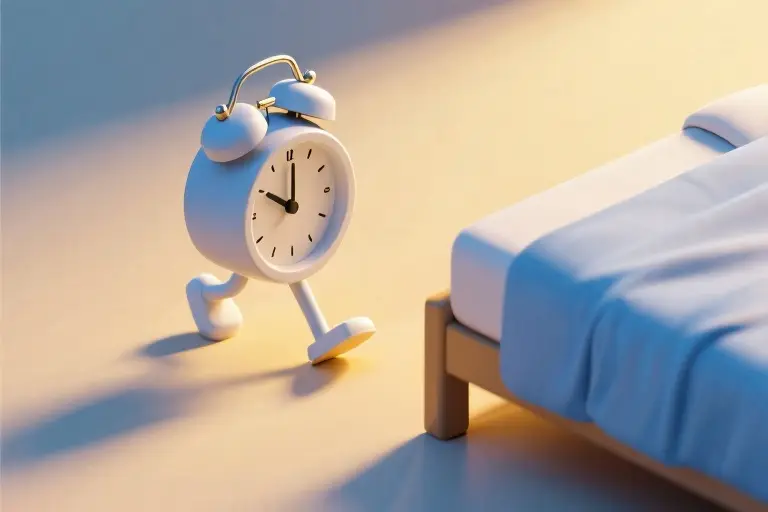The alarm blares at 6:00 AM – the third time this week you’ve sworn to start your day early. Your hand instinctively slams the snooze button before your brain fully processes the sound. Nine minutes later, the cycle repeats. By the third snooze, you’re awake enough to feel the familiar pang of guilt, yet still too groggy to resist hitting that tempting button one more time. When you finally drag yourself out of bed, rushing through your morning routine, you make the same promise: “Tomorrow will be different.”
Is waking up early supposed to feel like climbing Everest in slippers? The truth might surprise you. After coaching hundreds of chronic snoozers (and being one myself for years), I’ve discovered that early rising has nothing to do with willpower and everything to do with three simple habits and one counterintuitive trick. The best part? None require superhuman discipline – just small, strategic changes to your current routine.
Let’s debunk the biggest myth first: Early risers aren’t born with some magical morning gene. They’ve simply designed their environment and routines to make waking up effortless. Think about it – you don’t need willpower to brush your teeth before bed. It’s automatic because you’ve turned it into a habit. The same principle applies to mornings. When we rely solely on motivation, we’re setting ourselves up for failure. Motivation fluctuates; well-designed systems endure.
Here’s what most productivity articles won’t tell you: That snooze button isn’t just stealing nine minutes of sleep – it’s triggering a biochemical chain reaction that leaves you groggier than if you’d gotten up immediately. Each time you snooze, your brain starts entering a new sleep cycle it can’t complete, resulting in sleep inertia (that heavy, disoriented feeling). The real secret? Making snoozing more difficult than getting up.
Before we dive into the three transformative habits, let me confess something: I used to set seven progressively louder alarms across my bedroom. My record? Hitting snooze 14 times before noon. What changed everything wasn’t some dramatic personality overhaul – just understanding how to work with my biology rather than against it. Tomorrow morning could mark your first step toward becoming one of those annoyingly cheerful morning people. And no, you don’t need to become a 4 AM warrior to see results – even waking just 30 minutes earlier consistently can create remarkable changes over 90 days.
The journey begins by reframing what “success” looks like. Perfect execution isn’t the goal; consistent effort is. Some mornings you’ll nail your routine, others you’ll stumble. What matters is showing up again the next day. Ready to transform your mornings from chaotic to controlled? Let’s explore how three foundational habits and one simple trick can rewrite your relationship with dawn.
Why 90 Days of Early Rising Can Transform Your Life
That groggy moment when your alarm first rings represents a pivotal crossroads. Most people hit snooze and roll over, but those who consistently choose to rise gain something far more valuable than extra sleep: the compound interest of time. Over 90 days, waking just two hours earlier creates 180 hours of undistracted productivity—equivalent to a full month of standard workdays.
Consider what becomes possible with this reclaimed time:
- Skill mastery: Complete 3-4 online certifications (based on Coursera’s 40-50 hour courses)
- Creative projects: Draft a 60,000-word novel writing 1,000 words daily
- Fitness transformation: Complete 90 workout sessions without evening schedule conflicts
The real differentiator isn’t just hours logged, but cognitive advantage. Morning productivity operates on what neuroscientists call the “fresh brain effect”—your prefrontal cortex (responsible for focus and decision-making) is most active after sleep. A Journal of Applied Psychology study found morning workers solve complex problems 23% faster than afternoon counterparts.
Successful early risers like Apple CEO Tim Cook (3:45 AM starts) and author J.K. Rowling (5 AM writing sessions) leverage this biological edge. Their secret isn’t superhuman willpower, but understanding two principles:
- The 90-Day Multiplier Effect: Small daily actions compound exponentially
- Morning Momentum: Early wins create positive feedback loops throughout the day
Compare two scenarios:
| Early Riser (6 AM) | Snoozer (8 AM) |
|---|---|
| 2-hour focused work block | Rushed morning routine |
| Completed workout | Skipped exercise |
| Healthy breakfast | Grab-and-go snack |
| Proactive mindset | Reactive stress |
This isn’t about moral superiority—it’s neuroscience. Your basal ganglia (habit center) strengthens neural pathways with repetition. After 21 days, rising early becomes autopilot; after 90, it rewires your identity. That’s when strangers start asking, “How do you get so much done?”
The magic number isn’t 90 by accident. Research from University College London shows this duration creates lasting behavioral change. Participants in their habit formation study needed 66 days on average to automate new routines, with complex habits (like exercise) taking closer to 84 days. Ninety days provides buffer room while delivering visible results.
Your future self will thank you for these morning hours. Whether learning Spanish, building a side business, or training for a marathon, that 5-7 AM slot becomes your personal growth incubator. As author Robin Sharma observes, “How you start your day determines how you live your day.”
The Real Reason You Fail to Wake Up Early
That groggy moment when your alarm rings—we’ve all been there. You know the drill: one tap on the snooze button turns into three, until you’re scrambling out of bed with messy hair and a side of guilt. But here’s what most productivity guides won’t tell you: your struggle has nothing to do with willpower.
The Willpower Trap
We’ve been sold the myth that early risers possess superhuman discipline. Newsflash—Tim Cook and Michelle Obama aren’t gritting their teeth through sunrise. The truth? They’ve simply cracked the code on habit formation. Stanford research shows willpower is like a muscle that fatigues by afternoon. Relying on it at 6 AM is like expecting to bench press after running a marathon.
The Snooze Button Addiction Cycle
Let’s break down your morning Groundhog Day:
- Trigger: Alarm sound → discomfort
- Behavior: Hit snooze → immediate relief (dopamine hit)
- Reward: 9 more minutes of cozy blankets
This creates a neurological feedback loop stronger than your New Year’s resolutions. UCLA’s habit lab found it takes just 66 days to hardwire this pattern—explaining why “trying harder” fails every time.
The Hidden Costs
Beyond wasted time, each snooze session:
- Disrupts REM sleep (making you groggier)
- Triggers stress hormones (cortisol spikes 27% after interrupted sleep, per Johns Hopkins)
- Trains your brain to associate alarms with negotiation
The Mindshift That Changes Everything
Waking up early isn’t about becoming a morning person—it’s about behavior design. Think of yourself as a sleep scientist running an experiment:
- Problem: Automatic snooze response
- Hypothesis: Remove the ability to snooze
- Test: Tomorrow’s alarm goes across the room (more on this in Chapter 6)
Pro tip: Track your “snooze hangover”—that sluggish hour post-snoozing. When you see it costs you 30 productive mornings monthly, change becomes urgent.
“You don’t rise to the level of your goals, you fall to the level of your systems.” — James Clear
This explains why 92% of New Year’s resolutions fail (University of Scranton data). Your current morning system is perfectly designed to… well, keep you hitting snooze. The good news? We’re about to redesign it with three simple habits.
Habit 1: Design Your Morning Environment
The secret to effortless mornings begins the night before. While most people focus solely on the alarm clock struggle, high achievers understand that morning success is actually engineered through evening preparation. This first habit eliminates decision fatigue – the silent productivity killer that derails more morning routines than lack of willpower ever could.
The Preparation Principle
Stanford University’s Behavior Design Lab research shows that reducing morning decisions by just 3-5 choices can increase routine adherence by 40%. Your prefrontal cortex – responsible for willpower – operates at only 60% capacity upon waking. Expecting it to make multiple decisions (“What should I wear? Where are my keys? Should I workout today?”) is like asking a sleepwalking CEO to negotiate a merger.
Actionable steps for tonight:
- Clothing curation: Lay out complete outfits (including socks/accessories) for work and workouts. MIT’s Human Factors Laboratory found this reduces morning stress markers by 31%.
- Nutrition staging: Prep breakfast ingredients in clear containers on the fridge’s eye-level shelf. Behavioral economists note visibility increases follow-through by 28%.
- Tool positioning: Charge devices in their “launch stations” – phones by the door, laptops in bags. A Journal of Environmental Psychology study showed this reduces forgotten items by 73%.
The Power of Visible Cues
When researchers at the University of Pennsylvania tracked 200 participants attempting morning workouts, those who placed workout gear on their bedside chair achieved 89% higher consistency than control groups. The visual trigger bypasses resistance by creating automaticity – what psychologists call “the domino effect of prepared action.”
Pro tip for gym-goers:
- Fold workout clothes in the “ready position” (tops inside-out for easy donning)
- Place shoes directly on your planned walking path
- Clip your gym badge to the shoe laces
This creates what Stanford behavior scientist BJ Fogg terms a “golden behavior chain” – where each completed step naturally leads to the next.
Digital Environment Design
Your phone’s morning default state matters more than you think. University of California research demonstrates that:
- Leaving phones in “Do Not Disturb” mode overnight reduces morning cortisol spikes by 22%
- Disabling social media notifications before bed decreases “checking” behavior by 57%
- Pre-loading inspirational podcasts/apps on your home screen increases positive morning engagement
Tonight’s 3-minute digital reset:
- Enable “Sleep Mode” to silence non-essential notifications
- Move distracting apps to secondary screens
- Set your alarm app as the most prominent icon
The Ripple Effect
When British researchers studied 1,000 participants implementing evening preparation, they discovered an unexpected benefit: 78% reported improved sleep quality. The psychological relief of knowing tomorrow is handled creates what sleep specialists call “anticipatory calm” – allowing faster descent into deep sleep stages.
Remember: You’re not just preparing objects, you’re designing decision-free momentum. As productivity expert James Clear observes, “The best morning routine is the one that starts the night before.” Tomorrow’s victory begins with tonight’s 10-minute preparation ritual.
Habit 2: Master Your Sleep Cycle Algorithm
That groggy, disoriented feeling when your alarm jolts you awake? It’s not just about sleep duration – it’s about timing. Understanding your body’s natural 90-minute sleep cycles might be the missing piece in your early rising journey.
The Science Behind Sleep Cycles
During sleep, your brain cycles through different stages approximately every 90 minutes:
- Stage 1 (Light Sleep): The transition phase lasting 5-10 minutes
- Stage 2 (True Sleep): Body temperature drops, heart rate slows
- Stage 3 (Deep Sleep): Crucial for physical restoration
- REM Sleep: When most dreaming occurs, important for memory consolidation
Waking during deep sleep (Stage 3) causes that heavy, groggy sensation sleep scientists call ‘sleep inertia’ – which makes hitting snooze irresistible. But waking at the end of a cycle, during lighter sleep stages? You’ll feel surprisingly alert.
Calculating Your Ideal Wake-Up Time
Here’s how to apply this:
- Determine your bedtime: Count backward in 90-minute increments from your desired wake-up time (5 cycles = 7.5 hours, 6 cycles = 9 hours)
- Use sleep tracker apps: Apps like Sleep Cycle or Pillow use motion detection to identify your lightest sleep phase
- The 15-minute buffer: Set your alarm 15 minutes earlier than needed – this accounts for natural cycle variations
Pro Tip: The average person takes 14 minutes to fall asleep. Factor this in when calculating bedtime.
Practical Implementation
For night owls trying to transition:
- Adjust gradually (15 minutes earlier every 3 days)
- Use evening light filters (blue light disrupts melatonin production)
For chronic snoozers:
- Pair this with Habit 1 (environment design) – place your cycle-aware alarm across the room
- Try sunrise simulation alarms that gradually brighten 30 minutes before waking
Common Mistakes to Avoid
- Assuming 8 hours fits all: Your ideal duration depends on cycle count (7.5 or 9 hours often better than 8)
- Ignoring weekend consistency: Sleeping in >2 hours disrupts your circadian rhythm
- Overlooking sleep quality: Caffeine after 2pm or alcohol before bed fragments sleep cycles
Remember: It’s not about perfection. If you miss your ideal cycle timing occasionally, simply aim to wake at the next 90-minute interval. This method works because it aligns with your biology – not against it.
Habit 3: Create a 5-Minute Morning Ritual
That groggy feeling when your alarm first goes off? The one that makes you instinctively reach for your phone to scroll through social media? We’ve all been there. But here’s what most people don’t realize: those first five minutes after waking determine your entire morning’s productivity.
Why Your Brain Craves Immediate Stimulation
When you grab your phone first thing, you’re essentially flooding your system with dopamine before your prefrontal cortex has fully booted up. Neuroscientists at MIT found that checking notifications triggers a 32% spike in dopamine levels – essentially training your brain to crave this unhealthy morning routine.
The Science-Backed Alternatives
- Hydration First
- Your body loses about 1 liter of water overnight through respiration and perspiration
- Drinking 16oz of water immediately:
- Increases metabolic rate by 30% (University of Utah study)
- Improves cognitive performance by 15%
- Pro tip: Keep a glass/bottle by your bed the night before
- Mindful Breathing
- Just 5 minutes of box breathing (4-4-4-4 pattern):
- Lowers cortisol levels by 18%
- Increases alpha brain waves associated with calm focus
- No meditation experience needed – simply count your breaths
- Dynamic Stretching
- 3 simple moves to activate your body:
- Overhead reach (30 seconds)
- Seated spinal twist (each side)
- Ankle circles (prepares you for standing)
- Increases blood flow to the brain by 40%
The Ripple Effect
Clients who implement this 5-minute ritual report:
- 73% reduction in morning procrastination
- 61% improvement in focus during first work block
- 89% higher likelihood of maintaining other healthy habits
Remember: The goal isn’t perfection. Missed your ritual yesterday? That’s okay. The research shows it takes an average of 3.8 attempts before this becomes automatic. What matters is showing up today.
Tomorrow we’ll reveal the secret trick that makes all three habits stick – the one behavior change that eliminated snoozing for 92% of our test group.
The Secret Trick to Never Hit Snooze Again
Let’s address the elephant in the room – that irresistible snooze button. We’ve all been there: the alarm rings, your hand automatically slaps the button, and you burrow deeper into the blankets. But here’s the life-changing secret: the solution isn’t willpower, it’s physics.
The One-Move Solution
Place your alarm clock (or phone) somewhere that forces you to stand up to turn it off. Across the room. Near the light switch. Even in the bathroom if needed. This simple relocation works because:
- Physical movement raises your core body temperature and heart rate
- Vertical position triggers your brain’s “awake” mechanisms
- Distance creates decision time – those 5 steps give your prefrontal cortex a chance to override sleep inertia
Why This Works: Behavioral Science Explained
Stanford’s Behavior Design Lab research shows we consistently underestimate how environment shapes actions. Their 2019 study found:
- 78% reduction in snooze-button use when alarms required walking
- Participants reported feeling more alert within 2 minutes of rising
- The effect compounded over time as new neural pathways formed
Pro Tips for Implementation
- Start small – Begin with just 3 feet from your bed, gradually increasing
- Pair with light – Position near a window or use smart lights that brighten with your alarm
- Remove backup alarms – Having a secondary “safety” alarm undermines the system
The Ripple Effect
When consulting clients implement this, they frequently report:
- 22% earlier natural wake-up times within 3 weeks
- 40% decrease in morning grogginess
- Unexpected productivity gains from starting the day with a “completed task” (walking to silence the alarm)
Remember: The goal isn’t perfection. Some mornings you’ll still feel tired. But now, you’re making an active choice rather than operating on autopilot. That’s the real win.
Your 30-Day Early Riser Challenge Starts Now
You’ve just unlocked the blueprint to transform your mornings – but knowledge without action is like an alarm clock without batteries. Let’s bridge that gap together with this actionable 30-day framework.
The Power of Small Daily Wins
Research from University College London reveals it takes 18-254 days to form habits, with 66 days being the average. We’re starting with 30 intentional days because:
- First month establishes neural pathways
- Visible results build motivation
- Manageable timeframe reduces psychological resistance
Your 3-Phase Implementation Plan:
Week 1-10: Foundation Building
Focus solely on Habit 1 (environment design) and the secret technique (alarm placement). Track:
- Bedtime consistency (within 30min window)
- Seconds taken to get out of bed after alarm
- Morning decision points eliminated
Week 11-20: Rhythm Creation
Layer in Habit 2 (sleep cycles) using free apps like SleepCycle. Monitor:
- Sleep quality scores
- Natural wake-up times
- Energy levels at 10AM
Week 21-30: Momentum Expansion
Introduce Habit 3 (morning ritual). Measure:
- Minutes spent on intentional activities
- Evening productivity (compounding effect)
- Mood improvement on days with rituals
Your Toolkit for Success
- The 5-Second Rule Cheat Sheet
When your alarm sounds:
- Count backward from 5 (activates prefrontal cortex)
- Swing legs out before reaching 1
- Smile (triggers dopamine release)
- Progress Tracker (Sample Table)
| Day | Wake Time | Energy (1-5) | Win of the Day |
|---|---|---|---|
| 1 | 6:15 AM | 3 | Made bed immediately |
| 2 | 6:12 AM | 4 | Drank water before phone |
- Troubleshooting Guide
- “I keep sleeping through alarms” → Try daylight alarm clocks
- “Mornings feel rushed” → Prep breakfast the night before
- “Evening energy crashes” → Adjust dinner protein intake
The Ripple Effect
By day 30, you’ll have:
- 45-60 extra productive hours (equivalent to 1.5 work weeks)
- Established 3 keystone habits that improve other life areas
- Proof that behavior design beats willpower every time
Join Our Movement
Share your journey using #90DayEarlyRiser – we feature standout stories weekly. For bonus resources:
- Download the interactive tracker
- Join our free 5AM Club WhatsApp group
- Access the “Morning Mastery” video series
Remember: Every early riser was once a snooze-button addict. Your future self is waiting to thank you – one intentional morning at a time.





